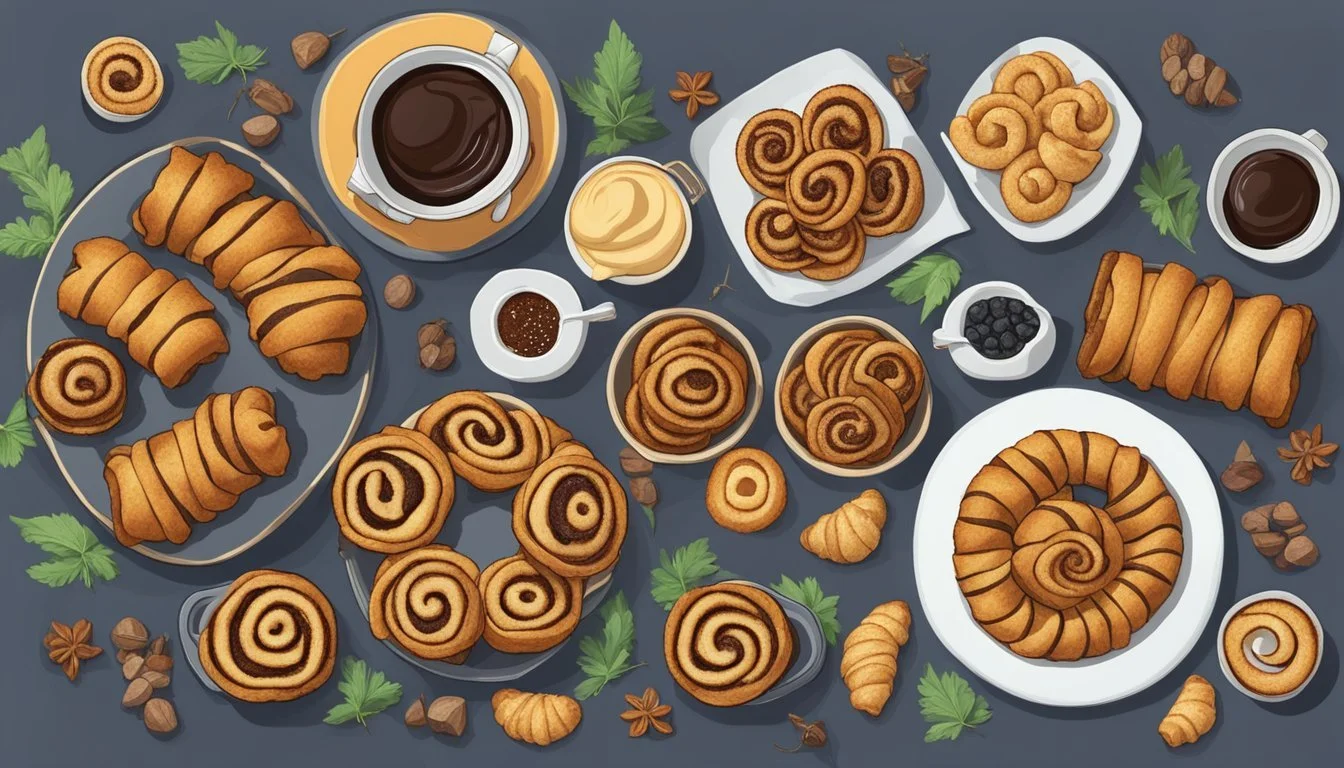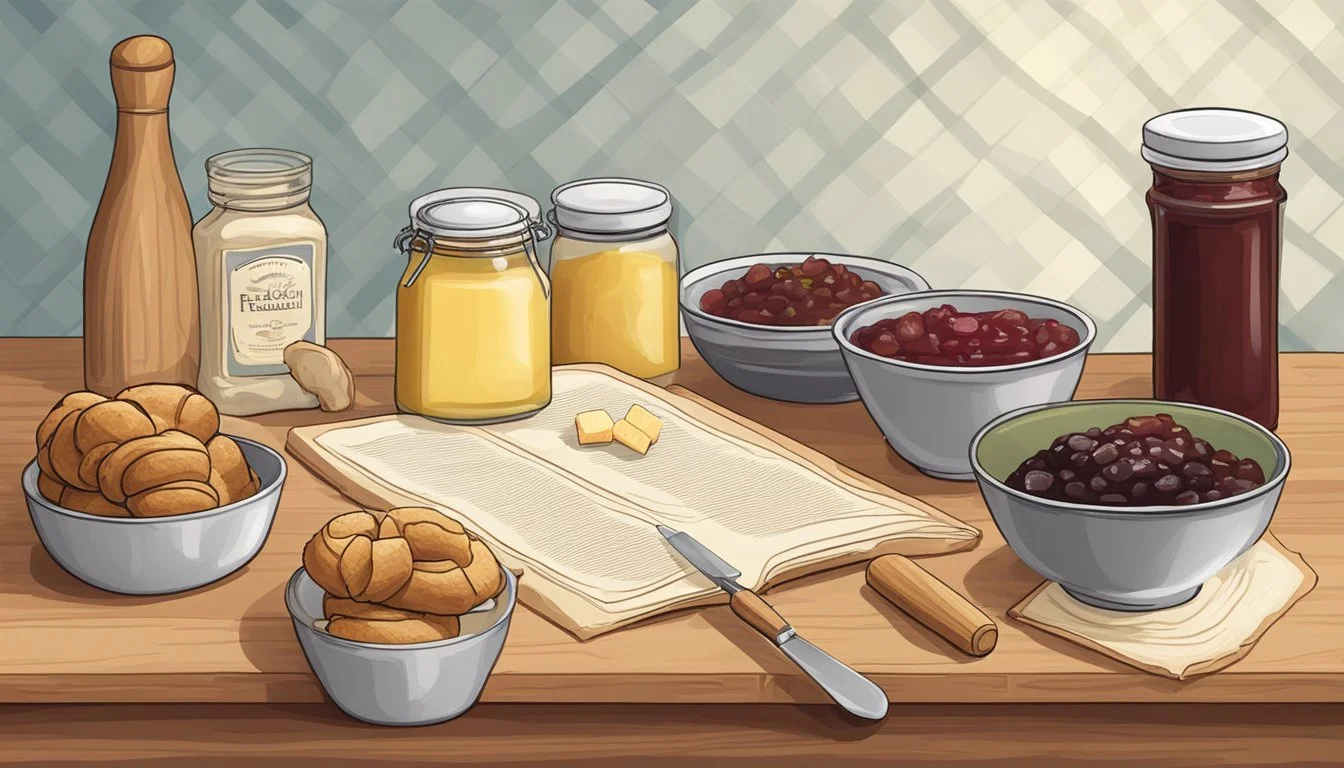Are Rugelach Vegan?
Unveiling the Facts on Dairy and Egg Content
Rugelach, a Jewish pastry that traditionally features a cream cheese-based dough, is a beloved treat often enjoyed during festive occasions. The classic recipe is not vegan, as it contains dairy products like cream cheese and butter. However, the rise of plant-based eating has led to the creation of vegan rugelach recipes that substitute these ingredients with vegan alternatives such as plant-based cream cheeses and butters.
Bakers have successfully adapted the recipe to cater to a vegan diet without compromising on the pastry's rich, flaky texture and delectable taste. Vegan rugelach maintains the essence of the traditional dessert, using a variety of plant-based ingredients and fillings, ranging from dried fruits and nuts to vegan chocolate spreads. These vegan versions provide an inclusive option for those adhering to a vegan lifestyle or for individuals looking for dairy-free dessert alternatives.
What Is Rugelach?
Rugelach is a traditional Jewish pastry that is popular in Jewish cuisine, particularly within the Ashkenazi community. It's commonly associated with festive occasions and is savored as a dessert or a sweet snack throughout the day.
Origin and Evolution: The name rugelach is Yiddish for "little twists," which aptly describes their shape. These pastries boast European roots, reflecting the rich heritage and culinary traditions of the Jewish people.
Ingredients and Variations: Typically, rugelach is made from a dough that includes cream cheese, butter, flour, and sugar—a combination resulting in a tender and flaky texture. The dough is rolled into a triangle or crescent shape and filled with an assortment of sweet ingredients such as:
Fruit jams (commonly apricot or raspberry)
Chocolate (often chocolate chips or spread)
Nuts (like walnuts, almonds, or pecans)
Cinnamon and sugar
Baking Process: After filling, the dough is rolled into logs or crescents and then baked to a golden brown. The finished product is sometimes topped with a glaze or sprinkled with powdered sugar to add a finishing sweet touch.
Cultural Significance: Rugelach holds a cherished place on the dessert tables at various Jewish celebrations, including Hanukkah and Shabbat. Despite its traditional roots, rugelach has gained popularity beyond the Jewish community and can be found in various bakeries and cafes.
Vegan Considerations: Traditionally, rugelach is not vegan due to dairy ingredients. However, vegan versions replace dairy products with plant-based alternatives such as vegan cream cheese and butter, making them suitable for those adhering to a vegan diet.
Origins and Cultural Significance
Rugelach is an iconic pastry deeply ingrained in Jewish culture, often associated with celebrations and holidays. Its evolution reflects the adaptability of Jewish culinary traditions.
Jewish Culture and Traditions
Rugelach, a pastry with Eastern European roots, has woven itself into the fabric of Jewish culture. These pastries, traditionally made with a dough enriched with cream cheese or sour cream, are commonly shaped into crescents and filled with a variety of sweet ingredients such as fruit preserves, nuts, and cinnamon. They are a staple in Jewish bakeries and home kitchens, serving not only as a delicious treat but also as a symbol of heritage.
Common Fillings:
Fruit preserves
Chopped nuts
Chocolate
Cinnamon sugar
Bakers celebrate rugelach for its versatility, often experimenting with fillings to create unique flavor combinations that still honor the traditional methods. This adaptability allows rugelach to maintain its relevance across generations within the Jewish diaspora.
Hanukkah and Rugelach
During Hanukkah, the eight-day Festival of Lights, rugelach find a special place among other holiday foods. They are not traditional to the holiday in the same way that sufganiyot (jelly doughnuts) or latkes (potato pancakes) are, but their sweetness and the care that goes into preparing them resonate with the spirit of joy and togetherness that Hanukkah embodies.
Holiday Associations:
Rugelach: plentiful, diverse
Sufganiyot: traditionally linked with Hanukkah
Latkes: a holiday staple
As a holiday cookie recipe, rugelach may be prepared and shared during Hanukkah gatherings, reflecting the joyful and communal nature of the festivities. They illustrate how Jewish cuisine can incorporate traditional holiday foods with treats that, while not exclusive to the holidays, have a special place in celebrations due to their cultural significance.
Understanding Veganism
In this section, the essence of veganism and its dietary foundations are explored to shed light on the principles that guide vegan choices.
What Does Vegan Mean?
Veganism is a lifestyle choice that excludes all forms of animal exploitation and cruelty for food, clothing, or any other purpose. Vegans opt not to consume meat, dairy, eggs, or any products derived from animals. The philosophy extends beyond diet, influencing one’s choices in personal care, fashion, and other consumer goods.
The Vegan Diet Essentials
The vegan diet is rich in plant-based foods. Essentials include:
Fruits and Vegetables: A wide variety provides vitamins, minerals, and fiber.
Legumes: Such as beans, lentils, and chickpeas, which are important protein sources.
Nuts and Seeds: These provide healthy fats and protein.
Whole Grains: Sources of complex carbohydrates and fiber, including quinoa, brown rice, and oats.
Plant-based Milks and Yogurts: Often fortified with calcium and vitamin B12.
Vegans also ensure they consume adequate substitutes for nutrients commonly found in animal products, such as vitamin B12, omega-3 fatty acids, iron, calcium, and protein. It's common for vegans to use supplements or consume fortified foods to meet their nutritional needs.
Ingredients of Traditional Rugelach
Traditional rugelach is a Jewish pastry that blends a flaky, buttery crust with sweet and rich fillings. Most commonly, the pastry incorporates dairy products and a variety of fillings to cater to different tastes.
Common Filling Varieties
Cinnamon Sugar: A mixture of cinnamon and sugar is a classic choice, offering a warm, spicy flavor.
Chocolate: Finely chopped chocolate or chocolate chips provide a rich, indulgent filling.
Jam: Fruit jams, such as apricot or raspberry, give a sweet and tangy taste.
Nuts: Crushed nuts, such as walnuts or pecans, add a crunchy texture.
Raisins: Often soaked in water or liquor, raisins bring in a chewy sweetness.
Poppy Seeds: Poppy seed filling is a traditional choice with a unique, nutty flavor.
The Role of Dairy in Rugelach
The dairy components are essential in achieving the tender texture of rugelach pastry. Butter and cream cheese are both integral to creating the dough, which is known for its rich flavor and flakiness. Here's how each contributes to the pastry:
Butter: Provides moisture and facilitates the layering that gives rugelach its characteristic flake.
Cream Cheese: Adds a tangy flavor and tenderizes the dough, contributing to its unique texture.
Veganizing Rugelach
Traditional rugelach recipes often include dairy products and eggs, but these ingredients can be substituted with vegan alternatives to cater to a plant-based diet.
Dairy Alternatives
In the realm of vegan baking, dairy substitutes play a pivotal role. Two key dairy ingredients in rugelach—cream cheese and butter—can be easily replaced with their vegan counterparts without compromising texture or taste.
Vegan Cream Cheese: A variety of brands offer dairy-free cream cheese alternatives made from ingredients like nuts or tofu. These provide the desired creaminess and can be directly substituted in equal measurements.
Vegan Butter/Plant-Based Butter: When looking for a substitute for traditional butter, one can opt for vegan butter. It typically utilizes oils and emulsifiers to mimic the texture and melting properties of dairy butter. This can be cut into small chunks and used in the baking process just like dairy butter.
Egg Alternatives
Eggs in baking are commonly used for binding the ingredients together. In vegan rugelach, egg replacers are used not only to bind the dough but also to ensure the result is tender and flaky.
Egg Replacer: Commercial egg replacers are available in powder form which, when mixed with water, create a viscous solution that binds like an egg. Flax seeds or chia seeds mixed with water can also serve as natural, nutrient-rich egg substitutes.
By incorporating vegan cream cheese, plant-based butters, and effective egg replacers, rugelach can be enjoyed in a completely vegan form without sacrificing the beloved characteristics of this classic treat.
Vegan Rugelach Recipe
Transitioning traditional rugelach to a vegan version requires alternative ingredients for dairy and eggs, while maintaining the classic texture and taste. The following sections provide a specific recipe covering ingredients and procedures designed to yield delicious, flaky vegan rugelach.
Ingredient List
To make vegan rugelach, gather the following ingredients:
Dry Ingredients:
2 cups all-purpose flour
1/2 teaspoon salt
1/2 teaspoon baking powder
Wet Ingredients:
1 cup vegan butter, cold and cut into chunks
1/2 cup vegan cream cheese
1/4 cup granulated sugar (for jam mixture)
1 tablespoon lemon zest
1 teaspoon vanilla extract
Filling:
1/2 cup fruit jam of choice
Egg Replacer:
3 tablespoons aquafaba (chickpea brine)
Glaze (optional):
1/4 cup sugar
1/8 cup water
Preparation Steps
Before combining ingredients, preheat the oven to 350°F (175°C) and line baking sheets with parchment paper. In a mixing bowl, pulse together the dry ingredients to ensure they are well combined. Then, using a food processor, blend the cold vegan butter chunks with the dry mix until a breadcrumb-like texture is achieved, which typically takes about 30 seconds.
Mix in the wet ingredients—vegan cream cheese, vanilla extract, and lemon zest—until a dough forms. Roll the dough into two balls and chill them wrapped in plastic for at least an hour.
Baking and Storing Techniques
Once chilled, roll out one ball of dough with a rolling pin on a floured surface into a 9-inch circle. Spread a thin layer of the jam mixture onto the dough. Cut the circle into triangles with a sharp knife, roll each one from the wider end to the tip, and place them seam side down on the prepared baking sheets.
Bake for 15-20 minutes until they reach a golden brown hue. If desired, prepare a simple sugar glaze by heating sugar and water until the sugar dissolves, then brush it over the warm rugelach. They're best enjoyed fresh, but you can store them in an airtight container or freeze them for later enjoyment.
Nutritional Information and Dietary Considerations
Traditional rugelach are not typically vegan, as they contain butter, cream cheese, and sometimes egg. Vegan versions substitute these ingredients to align with plant-based dietary restrictions. This section details the nutritional components of vegan rugelach and highlights potential allergy concerns for those adhering to specific diets.
Caloric and Macronutrient Breakdown
Vegan rugelach typically constitute the following macronutrients:
Calories: A typical serving size could range from 80 to 150 calories, depending on ingredient substitutions and portion size.
Carbohydrates: Expect around 10 to 20 grams per serving, primarily from flour and sugar used in the dough and fillings.
Protein: Vegan rugelach contain minimal protein; usually less than 2 grams per serving.
Fats: Vegan butter and plant-based cream cheese are used in lieu of dairy, contributing to a variable fat content that can range from 4 to 10 grams per serving.
Given that these values can fluctuate based on recipe variations and specific brands of ingredients, it is crucial to consult individual product labels or recipes for exact figures.
Allergy and Dietary Restrictions
Vegan rugelach address several dietary restrictions:
Dairy-Free: Traditional dairy ingredients like butter and cream cheese are replaced with plant-based alternatives, such as vegan butter and non-dairy cream cheese, making the treats suitable for a dairy-free diet.
Vegan: Egg is commonly substituted with egg replacers, ensuring that the dessert complies with vegan standards.
However, individuals with allergies should note that vegan rugelach can still contain allergens such as:
Gluten: Standard recipes call for all-purpose flour.
Nuts: Often used in fillings, posing a risk to those with nut allergies.
Soy: Some vegan butter and cream cheese brands contain soy.
For those with gluten sensitivities or other specific dietary needs, specialty recipes utilizing gluten-free flour or omitting nuts can be sought. Always review ingredients carefully when selecting or making vegan rugelach to ensure they are safe and appropriate for all dietary requirements.
Creative Variations and Substitutions
When preparing vegan rugelach, a variety of sweet and savory ingredients can be used to customize flavors. Key substitutions can be made to keep the pastry vegan while exploring different combinations of nuts, fruits, spreads, and spices.
Sweet and Savory Options
One can easily tailor vegan rugelach to suit a range of tastes by incorporating diverse sweet and savory fillings. Chocolate chips or Nutella provide a rich, sweet flavor, while a hint of vanilla extract adds a classic aromatic touch. For a more complex taste, lemon zest or a spread of apricot preserves brightens the pastry. Savory variations might include a blend of spinach with vegan cheese, delivering a different flavor profile altogether.
Nut and Fruit Alternatives
Nuts add a satisfying crunch and nutritional value to the dough. Variants like walnuts, pecans, and almonds not only yield distinct textures but also influence the taste. Opting for chopped walnuts or sliced almonds can enhance the overall mouthfeel. Peanut butter offers a smoother nut-based alternative to traditional fillings.
A mixture of fruit preserves, such as raspberry jam, apricot jam, or even less conventional fruit preserves, can infuse a sweet tartness. One may choose lighter dustings of powdered sugar to finish the pastry, thereby complementing the natural sweetness of the chosen fruit alternatives.
Baking Tools and Techniques
Creating vegan rugelach involves using precise tools and techniques to handle the pastry dough effectively. Careful preparation with these tools can significantly affect the texture and quality of the final product.
Using a Food Processor
A food processor is instrumental for quickly combining dry ingredients like flour, salt, and baking powder for vegan rugelach dough. Users can add cold butter in chunks to achieve a breadcrumb-like consistency. This method ensures even distribution of fats within the dough, which is critical for flakiness. For example, pulsing together these elements for specific intervals, such as 30 seconds, helps avoid overworking the dough.
Rolling and Cutting Dough
Once the dough is mixed, the next steps are rolling and cutting. A rolling pin is essential to evenly roll out the dough on a well-floured surface to prevent sticking. The target thickness is generally about an eighth of an inch. Tools like a sharp knife, pizza cutter, or a pizza wheel facilitate precise cutting of the dough into triangles before the filling is added and they are rolled into the classic rugelach shape. These tools allow for a clean cut, which is vital for the dough to maintain its shape during baking.
Storing and Serving Suggestions
Proper storage extends the freshness of rugelach, while an effective presentation enhances the overall enjoyment. This section details the practical steps to store rugelach and tips for serving them with finesse.
Storage Best Practices
Rugelach maintains its quality when stored in an airtight container to prevent staling. At room temperature, they remain fresh for up to a week; for longer storage, they may be frozen. To freeze rugelach, one should first ensure they are cooled completely to prevent condensation. Wrap them individually in plastic wrap before placing them in a container or sealable plastic bag. They can be stored in the freezer for up to three months. When ready to serve, thaw them at room temperature while still wrapped to avoid sogginess.
Presentation Tips
When serving rugelach, their iconic crescent shape and little twists should be prominently displayed. Arrange the rugelach in a circular pattern on a platter, with the narrow endpoints facing outward to highlight their shape. For added appeal, dust them lightly with powdered sugar or drizzle with a simple glaze. Ensure each serving has a uniform look and size, which not only makes for an attractive arrangement but also guarantees that all guests have an equal tasting experience.









